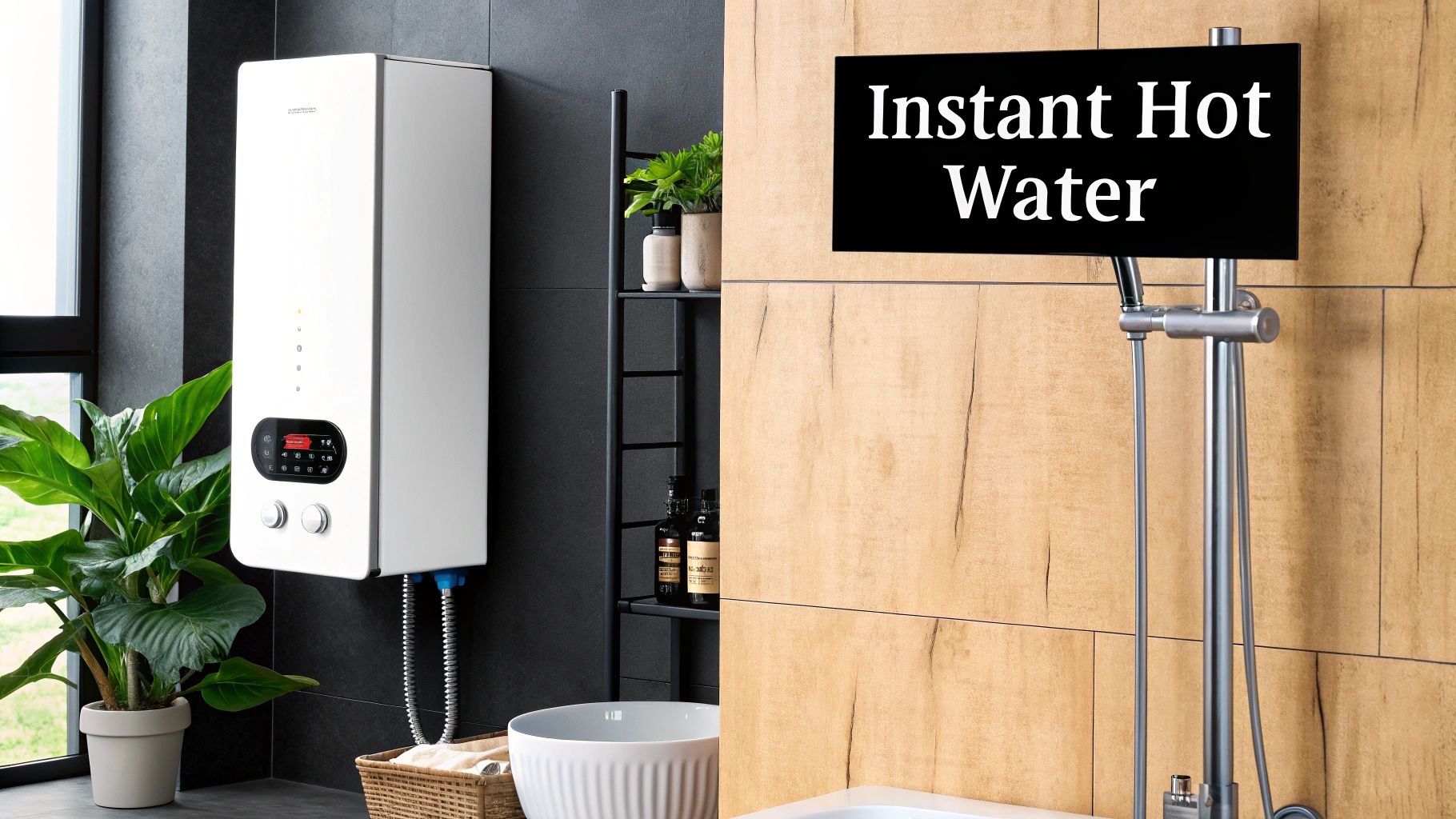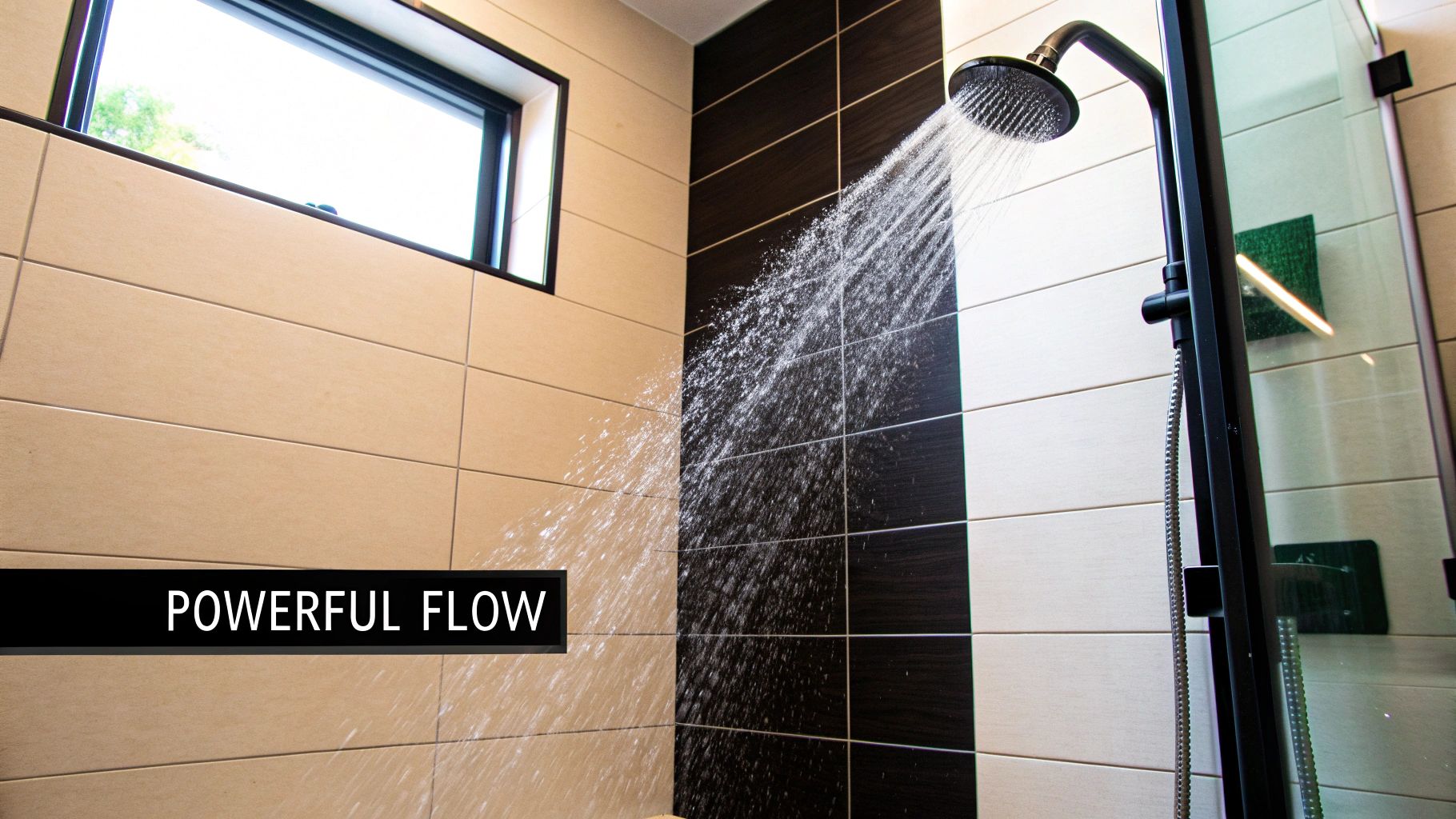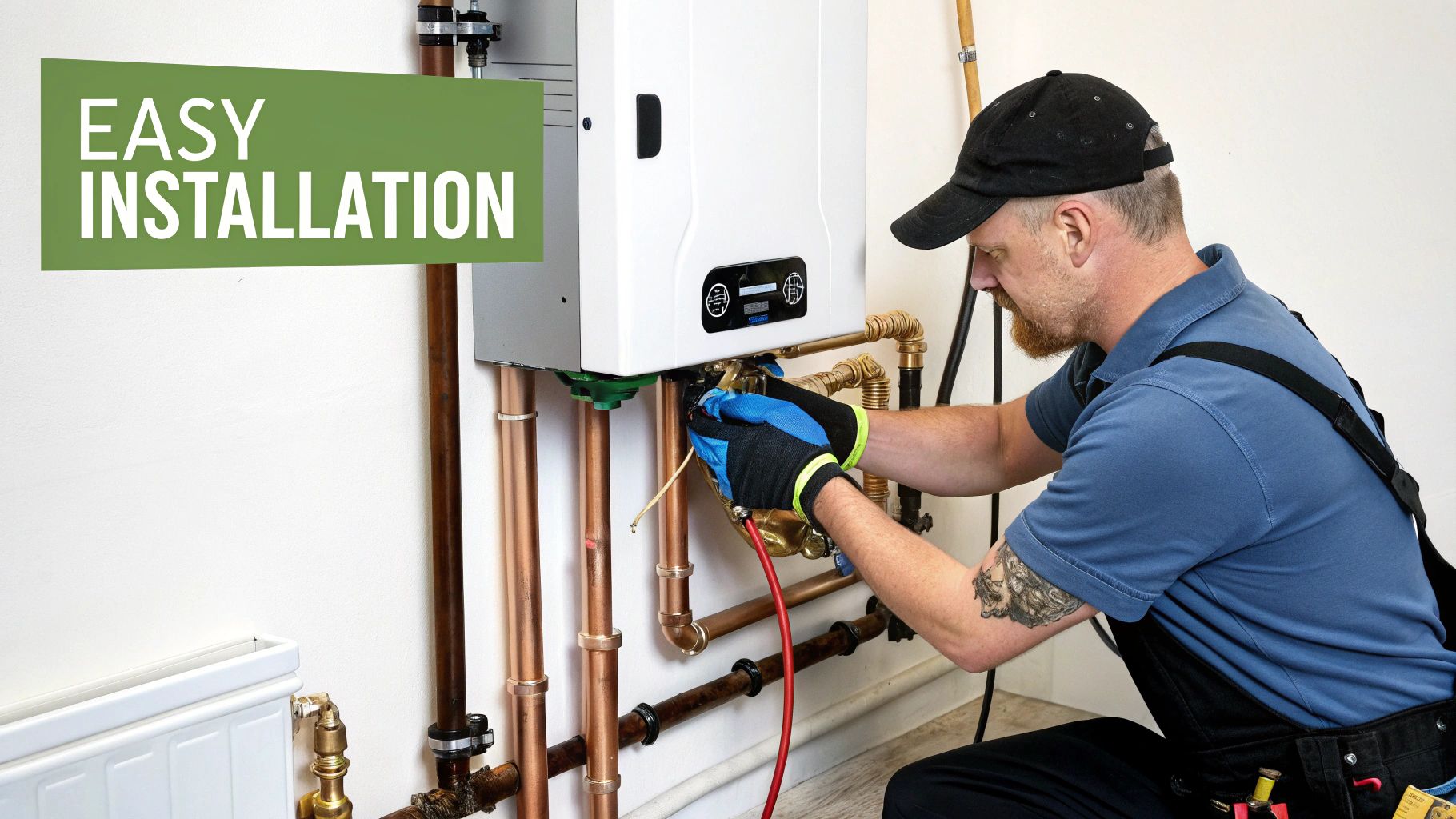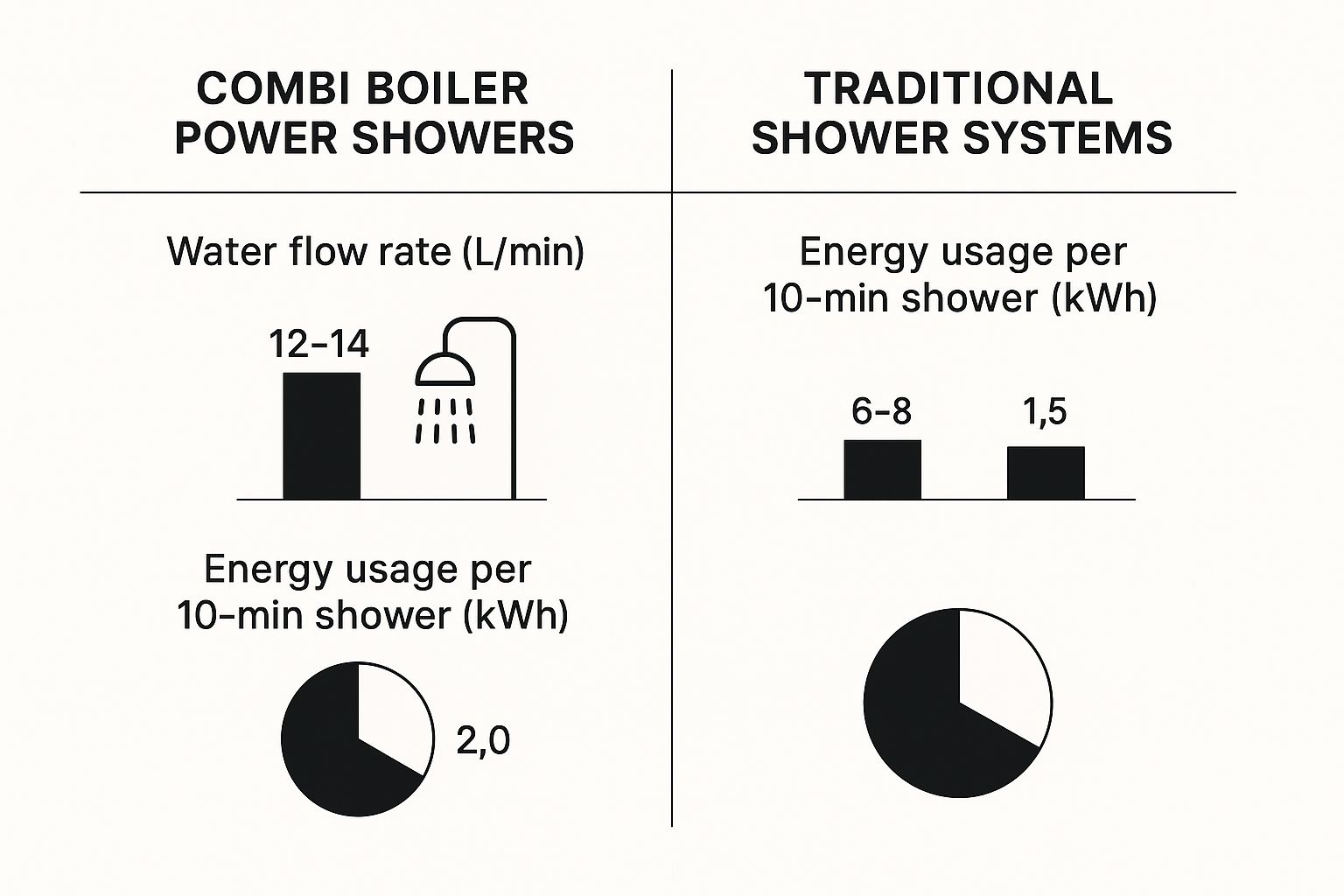Power Showers with Combi Boilers A Complete Guide
- Luke Yeates
- Sep 8
- 14 min read
So, can you actually use a power shower with a combi boiler? It’s one of those questions we get asked a lot at Harrlie Plumbing and Heating. While the short answer is technically yes, it’s rarely a good idea without getting an expert involved. It's a combination that’s traditionally seen as incompatible, and while specific setups can work, the risks often end up outweighing the benefits.
Understanding Power Showers With Combi Boilers

Everyone dreams of a powerful, invigorating shower, but pairing the wrong bits of kit can lead to some serious disappointment and even costly damage. The problem is that these two systems are designed to work in completely different ways. Your combi boiler is built to handle high-pressure mains water, whereas a power shower is designed to give a boost to low-pressure systems.
Think of your combi boiler as a single-lane country road – it can only handle a certain amount of traffic (hot water) at once. A power shower, with its internal pump, is like trying to force a motorway's worth of cars down that little lane. This mismatch is where the trouble starts.
Why The Conflict Exists
The main clash comes down to water pressure and flow rate. Combi boilers are high-pressure systems. They take water directly from your mains, heat it on the spot, and send it straight to your taps and shower without needing a storage tank.
A power shower, on the other hand, has its own built-in pump. Its entire job is to take hot and cold water from a low-pressure, gravity-fed system (the kind with a hot water cylinder and a cold water tank up in the loft) and give it some serious oomph.
At Harrlie Plumbing and Heating, we see this dilemma all the time in Eastbourne homes. People want a stronger shower, but hooking a power shower pump up to a high-pressure combi boiler puts immense strain on the boiler's internal parts. This can easily lead to leaks or, in the worst-case scenario, total system failure.
Key Factors To Consider
Before you even think about attempting this setup, its success hinges on two absolutely critical factors:
Your Home's Mains Water Pressure: First things first, the pressure coming into your property has to be strong enough for the combi boiler to do its job properly in the first place.
Your Boiler's Flow Rate: This is the maximum amount of hot water your boiler can churn out per minute. If a power shower's pump demands more water than the boiler can heat, you’ll be left with a lukewarm, disappointing trickle.
For homeowners in Eastbourne, a quick check can save a lot of headaches. We often find that older properties in areas like Meads have different mains pressure compared to newer builds near the marina, which is why a professional assessment is so important.
Compatibility Checklist for Combi Boilers and Power Showers
Here's a quick table to help you figure out if this setup is even a remote possibility for your home.
Factor | What It Means for Your Shower | Quick Tip |
|---|---|---|
Water Pressure Source | Combi boilers run on high-pressure mains water. Power showers are designed for low-pressure, gravity-fed systems. | A professional, like our team at Harrlie Plumbing and Heating, can measure your incoming mains pressure to see if it's strong enough. |
Boiler's Flow Rate (LPM) | Your boiler must be able to supply more hot water than the shower pump demands. A mismatch leads to poor performance. | Check your boiler's manual for its "DHW" (Domestic Hot Water) flow rate. This is a key number. |
Pipework Condition | Adding a pump increases stress on your pipes. Older pipework might not handle the extra pressure. | If your Eastbourne home has older pipes, get them inspected. A leak under the floorboards is the last thing you want. |
System Warranty | Installing an incompatible pump could void your boiler's warranty, leaving you with a hefty bill if things go wrong. | Always read the manufacturer's warranty terms before making any modifications to your heating system. |
This checklist should give you a clearer picture of why this isn't a simple plug-and-play solution.
Ultimately, getting your head around the mechanics of [power showers with combi boilers](https://www.harrlieplumbing.co.uk/post/power-shower-with-a-combi-boiler-a-plumber-s-guide) is the first step towards making a smart decision. Our plumber's guide dives deeper into this tricky topic, explaining exactly why this pairing is far more complex than it first appears.
How Your Combi Boiler Actually Works

To really get why pairing a power shower with a combi boiler is such a tricky business, you first need to understand what's going on inside that white box on your wall. It's a world away from the old-school systems with their big, clunky hot water tanks. A combi boiler is a marvel of on-demand efficiency, and there's a good reason it's become the top choice for most modern homes.
In fact, combi boilers are now the undisputed champions of the UK market, making up around 80% of all domestic boiler sales. Their popularity comes down to their space-saving size and their knack for delivering hot water the second you need it, which is perfect for so many properties in Eastbourne.
Think of it this way: a traditional system is like a big hot water urn, keeping a large amount of water hot all day just in case. A combi boiler is more like a super-fast, powerful kettle. It heats water directly from the cold mains supply the moment you turn on the hot tap.
The Critical Role of Flow Rate
If there's one thing to remember, it's flow rate. This isn't about pressure; it's all about volume. Measured in litres per minute (LPM), your boiler's flow rate is the absolute maximum amount of water it can heat to a certain temperature at any one time.
A pretty standard combi boiler will have a flow rate of about 11-13 LPM. That's generally plenty for running a bath or doing the washing-up. But here's the catch: this is a hard limit. Your boiler is physically incapable of producing more hot water per minute than its rating allows.
The flow rate of your combi boiler is the gatekeeper of your entire hot water system. Exceeding its capacity is like asking a single barista to instantly make coffee for ten people at once—the result will be weak, lukewarm, and disappointing for everyone.
How This Affects Your Home
This on-demand system has a knock-on effect throughout your home. Let's say you're enjoying a shower and someone starts washing up in the kitchen. The boiler now has to split its limited hot water production between two different taps. This is exactly why you might feel that sudden, unwelcome drop in temperature or flow.
Here in Eastbourne, where we at Harrlie Plumbing and Heating work on all sorts of properties, this is a classic scenario. A standard combi boiler in a Meads village home might be perfect for a single bathroom, but it'll start to struggle the moment multiple hot taps are turned on. This basic principle is crucial for understanding why a power shower—which is designed to aggressively demand a high volume of water—can so easily overwhelm a standard combi system.
For a deeper dive into these systems, check out our [essential guide to what a combi boiler system is](https://www.harrlieplumbing.co.uk/post/what-is-a-combi-boiler-system-essential-guide-for-eastbourne). This brings us right to the heart of the conflict between power showers and combi boilers.
Understanding Water Pressure and Flow Rate

This is where most of the confusion around power showers with combi boilers happens, so let's clear it up. Think of it like watering your garden with a hosepipe.
Water pressure is the force pushing the water out. It's what makes the water spray powerfully when you put your thumb over the end of the hose. In your home, this is the force pushing water in from the mains supply.
Flow rate, on the other hand, is the amount of water coming through. It’s how quickly you could fill a bucket. We measure this in litres per minute (LPM), and when it comes to your shower, it's dictated by the maximum output of your combi boiler.
They're two different things, but both are absolutely crucial for a good, hot shower.
Why Mains Pressure Is King in Eastbourne
Your home’s incoming mains water pressure is the boss; it dictates exactly what your combi boiler can deliver. Across Eastbourne, from seafront flats to the hillside homes in Old Town, mains pressure can be surprisingly varied.
A combi boiler is designed to work directly with this mains pressure. It takes the high-pressure cold water, heats it up on the spot, and sends it straight to your shower. A power shower, which is built to boost low-pressure systems, is a complete mismatch for a combi boiler that expects a high-pressure feed. It’s like fitting a turbocharger to an engine that’s already maxed out—it just creates problems and risks damage.
Here's the core issue: a power shower's internal pump tries to pull water through the system faster than your combi boiler is designed to heat it. This not only puts a huge strain on the boiler’s components but usually results in a weak, lukewarm shower—the exact opposite of what you wanted.
Perform a Simple 'Bucket Test' Yourself
Curious about your home's actual flow rate? You don't need any fancy gear to get a rough idea. You can do a quick "bucket test" right now.
Find a 10-litre bucket (a standard cleaning bucket is usually perfect) and a timer.
Head to the tap closest to your incoming water supply, which is normally the kitchen tap.
Turn the cold tap on full blast and start the timer immediately.
Stop the timer the second the bucket is full.
Now for a bit of simple maths to find your flow rate.
If it took 60 seconds (1 minute) to fill: You have a flow rate of 10 LPM.
If it took 30 seconds (0.5 minutes) to fill: Your flow rate is 20 LPM (10 litres / 0.5 minutes).
If it took 90 seconds (1.5 minutes) to fill: Your flow rate is about 6.7 LPM (10 litres / 1.5 minutes).
A flow rate below 10 LPM is generally considered low, and it can cause problems for combi boilers trying to supply a satisfyingly powerful shower. If your results are concerning, our team at Harrlie Plumbing and Heating can carry out a professional pressure and flow test for you right here in Eastbourne.
For a deeper dive into this topic, you can read our guide on [how to fix water pressure in your Eastbourne home](https://www.harrlieplumbing.co.uk/post/how-to-fix-water-pressure-easy-tips-for-your-eastbourne-home), which walks through solutions for improving your mains supply.
Choosing the Right Shower for Your Combi Boiler
Now that we’ve got the mechanics down, let’s get to the heart of the matter: picking the best shower for your combi boiler. This decision usually boils down to a straight choice between two very different types of showers, and each is built for a specific kind of plumbing system. Getting this right is the key to that fantastic, powerful shower you’re dreaming of—without causing a headache for your heating system.
On one hand, you’ve got the traditional power shower. These units have their own internal pump and are designed specifically for old-school, low-pressure gravity-fed systems. If you have a hot water tank tucked away in an airing cupboard and a cold water tank up in the loft, that’s the natural home for a power shower.
The Superior Choice for Combi Systems
On the other hand is the thermostatic mixer shower, which is the perfect partner for a modern combi boiler. Unlike a power shower, it doesn't have a pump. It simply takes the high-pressure hot and cold water your combi is already delivering and blends them together to a safe, steady temperature. It’s designed to work with your system, not fight against it.
This image clearly compares the performance and energy use you can expect from each setup.

As you can see, a mixer shower setup generally gives you a much better flow rate while using less energy. It’s simply a more efficient and effective choice for any home with a combi boiler.
Power Shower vs Mixer Shower for Combi Boiler Systems
To help Eastbourne homeowners make the safest and most effective choice, it's useful to see a direct comparison. This table breaks down the key differences between a power shower and a thermostatic mixer shower when paired with a combi boiler system.
Feature | Power Shower | Thermostatic Mixer Shower |
|---|---|---|
Compatibility | Not compatible; designed for low-pressure, gravity-fed systems. | Ideal match; designed to work with high-pressure combi systems. |
Internal Pump | Yes, contains a pump to boost water pressure. | No, uses the existing high pressure from the combi boiler. |
Risk of Damage | High risk of damaging the combi boiler by pulling water through too quickly. | No risk; works in harmony with the boiler's natural flow. |
Energy Efficiency | Low; the internal pump consumes extra electricity, increasing running costs. | High; uses no extra electricity, making it more energy-efficient. |
Installation | Complex and not recommended. Requires additional electrical wiring. | Straightforward installation by a qualified plumber. |
Performance | Can offer a powerful flow but at the cost of system health and efficiency. | Delivers a strong, consistent flow when paired with a good shower head. |
Best For | Older homes with a hot water cylinder and cold water tank (gravity-fed systems). | All modern homes with a combi boiler. |
Ultimately, the choice is clear. The thermostatic mixer shower is purpose-built for combi boilers, ensuring you get the performance you want without compromising the safety and longevity of your heating system.
A Real-World Eastbourne Example
Here at Harrlie Plumbing and Heating, we often get calls from homeowners in Eastbourne who are frustrated with their shower's poor performance. A recent client in the Roselands area had a great combi boiler but was getting just a weak trickle from their shower. They were convinced a power shower was the only solution.
When we took a look, we found the problem wasn't a lack of pressure at all. The culprit was an old mixer valve, completely clogged with limescale, that was restricting the water flow. We replaced it with a modern thermostatic mixer shower fitted with a wide, rainfall-style head.
The result was transformative. The client now enjoys a powerful, luxurious shower experience that uses their boiler's existing high pressure effectively. This approach solved the problem without risking damage to their heating system or installing an incompatible, energy-hungry pump.
This story highlights a crucial point for anyone thinking about a shower upgrade. Often, that feeling of a "powerful" shower comes from a high flow rate and a well-designed shower head, not necessarily from an external pump. Choosing the right mixer shower is the best way to get that invigorating experience while keeping your combi boiler safe and running efficiently.
Why Professional Installation Is a Must, Not a Maybe
Thinking about pairing a power shower with your combi boiler might seem like a straightforward weekend job, but trust me, this is one task you absolutely shouldn't DIY. Getting this wrong goes way beyond a disappointing trickle of water—it can cause serious, irreversible damage to the heart of your heating system and will almost certainly void your boiler's warranty on the spot.
Trying to tackle this yourself is a recipe for a very expensive headache. It's all about a delicate balance between your home's mains pressure, your boiler's specific flow rate, and the demands of a powerful shower pump. Without a deep understanding of how these systems interact, it's far too easy to create a setup that puts your entire boiler under immense strain, leading to a much shorter lifespan.
The Dangers of an Incorrect Setup
When you connect an incompatible pump to a combi boiler, you're essentially forcing two systems to fight each other. This conflict can have some grim consequences for your boiler.
Heat Exchanger Damage: The heat exchanger is the engine of your boiler. A power shower pump can yank water through it much faster than it was ever designed for. This causes massive thermal stress, which can lead to cracks and, ultimately, failure—a repair that can easily set you back hundreds of pounds.
Voided Warranty: Boiler manufacturers are crystal clear about what you can and can't connect to their products. Using an unapproved accessory like a power shower pump will instantly cancel your warranty, leaving you to cover the cost of any future repairs out of your own pocket.
Leaks and Pipework Stress: The extra pressure and turbulence created by a mismatched pump can put a huge strain on pipe joints and older pipework. This can cause hidden leaks to spring up behind walls or under your floorboards, leading to damp and damage you might not spot for months.
The Harrlie Plumbing and Heating Approach
This is exactly where calling in a professional is crucial to protect your home and your wallet. At Harrlie Plumbing and Heating, our process for clients across Eastbourne is designed to be thorough and safe, guaranteeing you get that fantastic shower experience you’re after while keeping your heating system happy.
We always start by carrying out a detailed assessment of your home's unique plumbing setup. This involves measuring your exact mains water pressure and running a flow rate test right at your taps. This first step is vital, as most UK combi boilers deliver hot water at around 9 to 12 litres per minute, while a power shower needs a minimum of about 10 litres just to work properly. You can find out more about this crucial balance from recent combi boiler market insights.
After assessing your system, we dive into your combi boiler’s specific technical details. From there, we’ll recommend a solution that’s a perfect match for what your boiler can handle—which is almost always a high-flow thermostatic mixer shower. This ensures you get a powerful, satisfying shower without any of the risks.
Ultimately, getting the installation right from the very beginning is the single best way to save money, avoid stress, and ensure your heating system stays healthy for years to come. It turns a risky gamble into a reliable, long-lasting upgrade you can enjoy every day.
Your Questions About Power Showers and Combi Boilers Answered
We’ve covered the technical side of things, but it’s natural to still have a few specific questions. This final section tackles the most common queries we hear at Harrlie Plumbing and Heating, giving you clear, straightforward answers to help you make the right choice for your home.
Will a Power Shower Break My Combi Boiler?
Yes, there’s a very high risk that it could. A power shower works by using an internal pump to aggressively pull water through the system. When you connect this to a mains-pressure combi boiler, it puts a huge amount of strain on the boiler's internal parts, especially the delicate heat exchanger.
This mismatch can lead to an early breakdown, expensive repairs, and will almost certainly void your manufacturer's warranty. This is exactly why we nearly always advise our Eastbourne clients against this combination. It's just not worth the gamble with such a crucial and costly appliance.
Can a Power Shower Fix My Home's Low Water Pressure?
No, and this is a very common misconception. A power shower is designed for one specific job: boosting water pressure in a low-pressure, gravity-fed system (the kind with a big tank in the loft). It cannot increase the incoming mains pressure that your combi boiler depends on.
If your home in Eastbourne has genuinely low mains pressure, a power shower will just struggle to draw enough water, leaving you with a weak, spluttering shower. The real fix involves tackling the mains supply itself, which usually means getting a specialist mains booster pump installed by a professional from Harrlie Plumbing and Heating.
A power shower is a bandage for a low-pressure gravity system, not a cure for a weak mains supply. Trying to use it for the wrong problem will only lead to frustration and potential damage.
What Is the Best Alternative for a Powerful Shower?
For a combi boiler system, the ideal and safest choice is a modern thermostatic mixer shower. These are specifically built to work perfectly with high-pressure systems like combis.
Many high-quality models today come with large "rainfall" or "drench" shower heads and are designed for high flow rates. They can deliver a genuinely powerful and luxurious shower experience without any of the risks that come with an incompatible pump. We frequently install these for clients all over Eastbourne, from modern flats near the Sovereign Harbour to older properties in the Old Town, and they are always delighted with the results.
How Do I Know if My Combi Boiler Is Strong Enough?
To figure this out, you'll need to look at your boiler's manual for its hot water "flow rate," which is measured in litres per minute (LPM). This number tells you the maximum amount of hot water it can produce at any one time.
Standard Performance: A boiler that provides 9-11 LPM is perfectly fine for a regular shower.
High Performance: For a truly high-performance shower with a big drench-style head, you should be looking for a combi boiler capable of 13 LPM or more.
Part of our standard consultation at Harrlie Plumbing and Heating involves checking your boiler's output and your home's actual flow rate. This guarantees that any new shower we install will live up to your expectations and work flawlessly with your existing system.
Making the right choice for your home’s heating and plumbing can feel complex, but you don’t have to do it alone. For expert advice and professional installation of showers and boilers in Eastbourne, trust the team at Harrlie Plumbing and Heating. Get in touch with us today for a no-obligation quote and enjoy a perfect shower experience, safely and efficiently. Visit us at https://www.harrlieplumbing.co.uk.

Comments